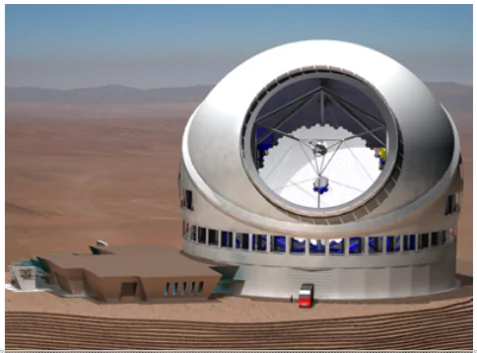Context:
Recently, an Indian delegation visited Mauna Kea, situated in Hawaii, USA to address the challenges faced by the Thirty Meter Telescope (TMT) project.

Astronomical Exploration and the Thirty Meter Telescope Project Decision
-
Mauna Kea is an inactive volcano on the island of Hawaii.
- Mauna Kea Observatories (MKO) comprises various independent astronomical research facilities and large telescopes.
- The location fits the project because of its characteristics: dark skies, absence of light pollution, elevated position, and exceptional astronomical seeing.
- The Indian project partners anticipate a conclusive choice between Mauna Kea in Hawaii and the Roque de los Muchachos Observatory (ORM) in the Canary Islands within the next 2 years.
Is Mauna Kea the highest mountain in the world?
- The tallest mountain in the world from base to peak is Mauna Kea, a long-dormant volcano in Hawaii, USA.
- In total, it is approximately 10,205m (33481 feet) in height, taller than Mount Everest’s 8,849m (29032 feet).
- Over half of Mauna Kea is underwater in the Pacific Ocean.
|
The Role & Advancements of Thirty Meter Telescope in Astronomical Exploration
-
Thirty Meter Telescope is an extremely large 30-meter optical/infrared telescope.
- Partners: Besides India, it has partners from the USA, China, Japan, and Canada.
India’s Role and Contribution:
- India, a partner in Thirty Meter Telescope, supports the development of the 30-meter telescope.
- India plans to contribute $200 million worth of hardware, software, and instruments.
- India will provide 83 out of the 492 mirrors for the telescope.
|
-
-
- The Aryabhatta Research Institute for Observational Sciences (ARIES), Nainital, the Indian Institute of Astrophysics (IIA), Bangalore and the Inter-University Center for Astronomy and Astrophysics (IUCAA), Pune are the three main institutes constituting Thirty Meter Telescope-India.
- Funding: India Thirty Meter Telescope will be jointly funded by the Departments of Science and Technology and Atomic Energy.
Technical Capabilities:
- It can collect over 12 times more light than the Hubble space telescope.
- This vastly expands the observational capacity for faint or very distant astronomical objects.
Thirty Meter Telescope’s Pioneering Research Frontiers
- Detecting oxygen in exoplanet atmospheres to find evidence of life
- Studying dark matter and dark energy
- Observing early galaxy formation after the Big Bang
- Capturing images of black holes.
Challenges Faced by Thirty Meter Telescope:
- Native communities have opposed the construction for cultural and religious reasons.
- The project’s substantial water requirements for construction and operation raise concerns about their impact on Mauna Kea’s already scarce water resources.
- The Thirty Meter Telescope project has encountered substantial cost overruns, causing concerns about its financial sustainability and ability to adhere to the initially allocated budget.
News source: The Hindu
![]() 13 Jan 2024
13 Jan 2024

